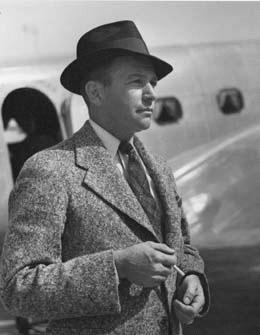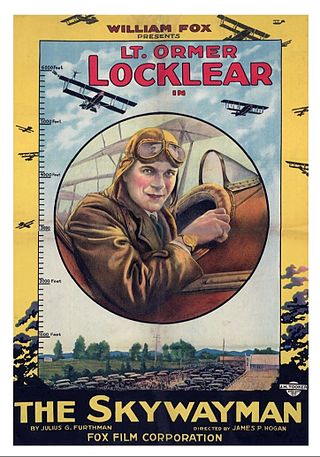
Aerobatics is the practice of flying maneuvers involving aircraft attitudes that are not used in conventional passenger-carrying flights. The term is a portmanteau of "aerial" and "acrobatics". Aerobatics are performed in aeroplanes and gliders for training, recreation, entertainment, and sport. Additionally, some helicopters, such as the MBB Bo 105, are capable of limited aerobatic manoeuvres. An example of a fully aerobatic helicopter, capable of performing loops and rolls, is the Westland Lynx.

Barnstorming was a form of entertainment in which stunt pilots performed tricks individually or in groups that were called flying circuses. Devised to "impress people with the skill of pilots and the sturdiness of planes," it became popular in the United States during the Roaring Twenties.

Ormer Leslie "Lock" Locklear was an American daredevil stunt pilot and film actor.

Beverly Homer DeLay was an American aviator who pioneered many of the popular stunts used in the early barnstorming air-shows. He soon adapted them for the movies, where he appeared with top Hollywood stars. DeLay died in a plane crash that was almost certainly caused by sabotage, but no one was ever charged in connection with the death.

Clyde Edward Pangborn, nicknamed "Upside-Down Pangborn", was an American aviator and barnstormer who performed aerial stunts in the 1920s for the Gates Flying Circus. He was its half-owner, chief pilot and operating manager, working in partnership with Ivan R. Gates. In 1931, Pangborn and co-pilot Hugh Herndon Jr. flew their plane, Miss Veedol, on the first non-stop flight across the Pacific Ocean.

Lincoln Beachey was a pioneer American aviator and barnstormer. He became famous and wealthy from flying exhibitions, staging aerial stunts, helping invent aerobatics, and setting aviation records.

The Great Waldo Pepper is a 1975 American drama film directed, produced, and co-written by George Roy Hill. Set during 1926–1931, the film stars Robert Redford as a disaffected World War I veteran pilot who missed the opportunity to fly in combat, and examines his sense of postwar dislocation in 1920s America. The cast includes Margot Kidder, Bo Svenson, Edward Herrmann and Susan Sarandon. The Great Waldo Pepper depicts barnstorming during the 1920s and the accidents that led to aviation regulations by the Air Commerce Act.

Roscoe Turner was a record-breaking American aviator who was a three-time winner of the Thompson Trophy air race and widely recognized by his flamboyant style and his pet, Gilmore the Lion.

Miss Veedol was the first airplane to fly non-stop across the Pacific Ocean. On October 5, 1931, Clyde Pangborn and co-pilot Hugh Herndon landed in the hills of East Wenatchee, Washington, following a 41-hour flight from Sabishiro Beach, Misawa, Japan, across the northern Pacific. The flight won the pair the 1931 Harmon Trophy in recognition of the greatest achievement in flight for that year.

Wing walking is the act of moving along the wings of an aeroplane during flight, sometimes transferring between planes. It originated as a daredevil stunt in the aerial barnstorming shows of the 1920s, and became the subject of several Hollywood movies. An early exponent was Ormer Locklear, who was killed performing a dive on film. Charles Lindbergh began his aviation career as a wing walker.

Alejandro "Álex" Maclean was a Spanish TV film producer and aerobatics pilot, who competed in the Red Bull Air Race World Championship under the number 36. Maclean was nicknamed "The Flying Matador".

Lillian Boyer was an American wing walker who performed numerous aerial stunts that included wing walking, automobile-to-airplane transfers, and parachute jumps between 1921 and 1929.

John Gilbert "Tex" Rankin was an aerobatic pilot, barnstormer, air racer, and flight instructor from the 1920s to the 1940s. He created the Rankin Flying Service which trained thousands of pilots at Rankin Field for the US Army Air Force in World War II. He was the 1935 US Aerobatic champion and 1938 World Aerobatic champion.

The Skywayman was a 1920 American silent action drama film directed by James P. Hogan and produced and distributed by Fox Film Corporation. The film starred noted aerial stunt pilot Ormer Locklear and Louise Lovely. After having appeared in The Great Air Robbery (1919), a film that showcased his aerial talents, Locklear, considered the foremost "aviation stunt man in the world", was reluctant to return to the air show circuit. During the production, Locklear and his co-pilot Milton "Skeets" Elliot died after crashing during a night scene. The Skywayman was subsequently released shortly after, capitalizing on their deaths.

The Great Air Robbery is a six-reel silent 1919 American drama film directed by Jacques Jaccard and produced by Universal Pictures. The film stars Ormer Locklear, Allan Forrest and Ray Ripley. The Great Air Robbery is a film that showcases the talents of stunt pilot Locklear, considered the foremost "aviation stunt man in the world", and depicts pilots flying air mail, the first film to deal with the subject. There are no known archival holdings of the film, so it is presumably a lost film.

Jimmy Marshall Franklin was an American aerobatic pilot. He performed at airshows, both solo and as part of teams, for over 38 years until his death at an airshow in Moose Jaw. Born and raised in Lovington, New Mexico, Franklin learned to fly at age 8 and bought his first airplane at 19 and flew his first airshow the same year.
Douglas Henry Davis was an early American aviator, barnstormer, air racer, flight instructor and commercial pilot.

John MacDonald Miller was a barnstorming pilot, the first person to make a US transcontinental flight in a rotorcraft, the first to land a rotorcraft on the roof of a building, and the first to fly a scheduled US mail rotorcraft service. He was also a test pilot and airline captain. He became the oldest active pilot in the US, making his first flight on his 18th birthday and ending at the age of 101. He died aged 102.
Ivan Rhuele "Van" Gates was an American aviator and entrepreneur. While a member of the San Francisco Police Department, he is credited with being the first to transport a prisoner by air. He founded or co-founded the barnstorming Gates Flying Circus, which attained much success and fame in the 1920s. Later, he and designer Charles Healy Day established the Gates-Day Aircraft Company, subsequently renamed the New Standard Aircraft Company, to design and manufacture airplanes.

















